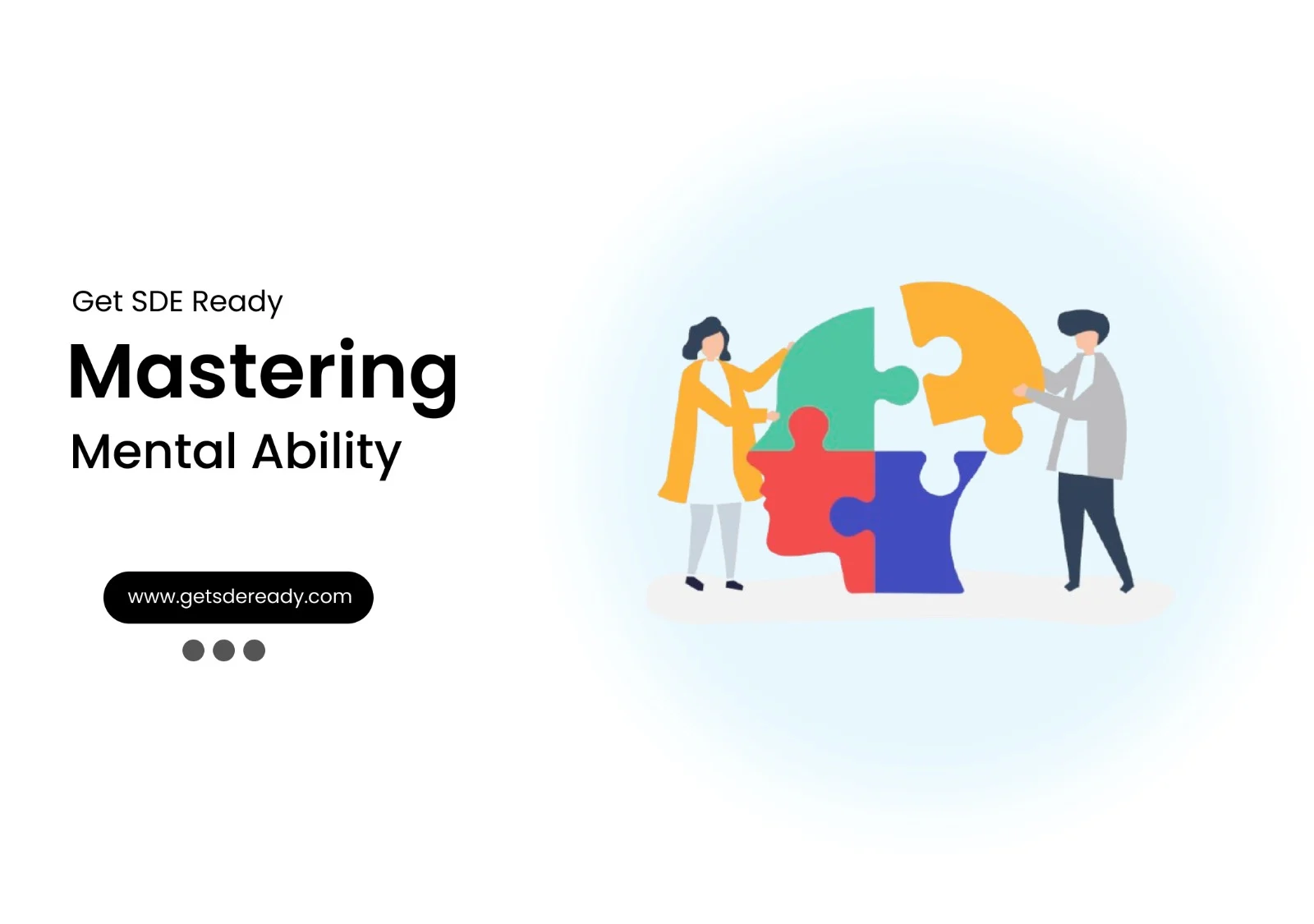Data Structures and Algorithms
- Introduction to Data Structures and Algorithms
- Time and Space Complexity Analysis
- Big-O, Big-Theta, and Big-Omega Notations
- Recursion and Backtracking
- Divide and Conquer Algorithm
- Dynamic Programming: Memoization vs. Tabulation
- Greedy Algorithms and Their Use Cases
- Understanding Arrays: Types and Operations
- Linear Search vs. Binary Search
- Sorting Algorithms: Bubble, Insertion, Selection, and Merge Sort
- QuickSort: Explanation and Implementation
- Heap Sort and Its Applications
- Counting Sort, Radix Sort, and Bucket Sort
- Hashing Techniques: Hash Tables and Collisions
- Open Addressing vs. Separate Chaining in Hashing
- DSA Questions for Beginners
- Advanced DSA Questions for Competitive Programming
- Top 10 DSA Questions to Crack Your Next Coding Test
- Top 50 DSA Questions Every Programmer Should Practice
- Top Atlassian DSA Interview Questions
- Top Amazon DSA Interview Questions
- Top Microsoft DSA Interview Questions
- Top Meta (Facebook) DSA Interview Questions
- Netflix DSA Interview Questions and Preparation Guide
- Top 20 DSA Interview Questions You Need to Know
- Top Uber DSA Interview Questions and Solutions
- Google DSA Interview Questions and How to Prepare
- Airbnb DSA Interview Questions and How to Solve Them
- Mobile App DSA Interview Questions and Solutions
DSA Interview Questions
- DSA Questions for Beginners
- Advanced DSA Questions for Competitive Programming
- Top 10 DSA Questions to Crack Your Next Coding Test
- Top 50 DSA Questions Every Programmer Should Practice
- Top Atlassian DSA Interview Questions
- Top Amazon DSA Interview Questions
- Top Microsoft DSA Interview Questions
- Top Meta (Facebook) DSA Interview Questions
- Netflix DSA Interview Questions and Preparation Guide
- Top 20 DSA Interview Questions You Need to Know
- Top Uber DSA Interview Questions and Solutions
- Google DSA Interview Questions and How to Prepare
- Airbnb DSA Interview Questions and How to Solve Them
- Mobile App DSA Interview Questions and Solutions
Data Structures and Algorithms
- Introduction to Data Structures and Algorithms
- Time and Space Complexity Analysis
- Big-O, Big-Theta, and Big-Omega Notations
- Recursion and Backtracking
- Divide and Conquer Algorithm
- Dynamic Programming: Memoization vs. Tabulation
- Greedy Algorithms and Their Use Cases
- Understanding Arrays: Types and Operations
- Linear Search vs. Binary Search
- Sorting Algorithms: Bubble, Insertion, Selection, and Merge Sort
- QuickSort: Explanation and Implementation
- Heap Sort and Its Applications
- Counting Sort, Radix Sort, and Bucket Sort
- Hashing Techniques: Hash Tables and Collisions
- Open Addressing vs. Separate Chaining in Hashing
- DSA Questions for Beginners
- Advanced DSA Questions for Competitive Programming
- Top 10 DSA Questions to Crack Your Next Coding Test
- Top 50 DSA Questions Every Programmer Should Practice
- Top Atlassian DSA Interview Questions
- Top Amazon DSA Interview Questions
- Top Microsoft DSA Interview Questions
- Top Meta (Facebook) DSA Interview Questions
- Netflix DSA Interview Questions and Preparation Guide
- Top 20 DSA Interview Questions You Need to Know
- Top Uber DSA Interview Questions and Solutions
- Google DSA Interview Questions and How to Prepare
- Airbnb DSA Interview Questions and How to Solve Them
- Mobile App DSA Interview Questions and Solutions
DSA Interview Questions
- DSA Questions for Beginners
- Advanced DSA Questions for Competitive Programming
- Top 10 DSA Questions to Crack Your Next Coding Test
- Top 50 DSA Questions Every Programmer Should Practice
- Top Atlassian DSA Interview Questions
- Top Amazon DSA Interview Questions
- Top Microsoft DSA Interview Questions
- Top Meta (Facebook) DSA Interview Questions
- Netflix DSA Interview Questions and Preparation Guide
- Top 20 DSA Interview Questions You Need to Know
- Top Uber DSA Interview Questions and Solutions
- Google DSA Interview Questions and How to Prepare
- Airbnb DSA Interview Questions and How to Solve Them
- Mobile App DSA Interview Questions and Solutions
Agile & Scrum Interview Questions for Project Managers
Agile is a project management methodology that prioritizes delivering small, incremental improvements to meet customer needs quickly. Scrum, a popular Agile framework, provides a structured approach to managing complex projects through defined roles, events, and artifacts. For project managers, mastering these concepts is essential to demonstrate leadership in dynamic environments. To boost your Agile skills and stay updated, sign up for our free courses at GetsdeReady.
Key Points
- Agile is a flexible, iterative approach to project management, while Scrum is a specific framework within Agile that emphasizes structured roles, events, and artifacts.
- Common interview questions for project managers focus on roles (Product Owner, Scrum Master, Development Team), ceremonies (Sprint Planning, Daily Scrum, Sprint Review, Retrospective), artifacts (Product Backlog, Sprint Backlog, Increment), and Agile principles.
- Research suggests that understanding practical applications, such as handling conflicts or scaling Agile, is as crucial as theoretical knowledge for interviews.
- The field is dynamic, with evolving tools and metrics like velocity and burndown charts being key to demonstrating expertise.
- Preparation should include real-world examples to showcase experience, as hiring managers value practical insights over rote definitions.
Roles and Responsibilities
What are the key roles in a Scrum team?
A Scrum team comprises three core roles:
- Product Owner: Manages the Product Backlog, prioritizes tasks based on business value, and ensures alignment with stakeholder needs.
- Scrum Master: Facilitates Scrum practices, removes impediments, and coaches the team on Agile principles.
- Development Team: A self-organizing, cross-functional group responsible for delivering the product increment, including tasks like coding, testing, and design.
Project managers often oversee teams working on diverse technologies. Enhance your understanding with our Data Science course.
How does the role of a project manager change in an Agile environment?
In traditional project management, project managers control planning, execution, and delivery. In Agile, their role shifts to facilitation and strategic oversight. The Scrum Master handles daily operations, allowing project managers to focus on stakeholder engagement, cross-team coordination, and scaling Agile practices. This requires adaptability and a focus on incremental value delivery.
What is the difference between a Scrum Master and a Project Manager?
- Scrum Master: A servant-leader who facilitates Scrum events, removes blockers, and promotes team self-organization without direct authority.
- Project Manager: Traditionally holds more authority, managing budgets, timelines, and resources. In Agile, they may focus on broader responsibilities like stakeholder management.
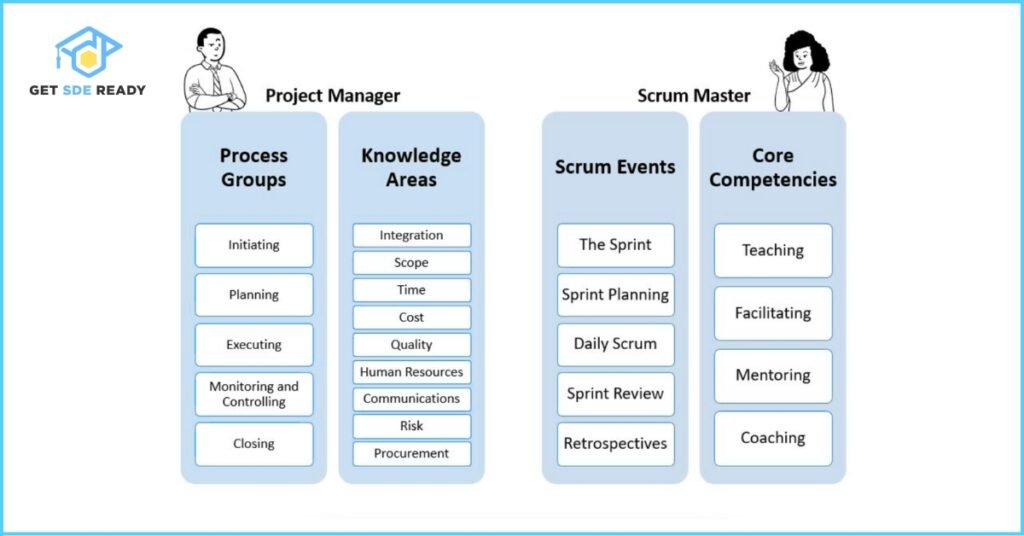
Explain the role of the Scrum Master.
The Scrum Master ensures the team adheres to Scrum practices, facilitates ceremonies, and removes obstacles. They coach the team on Agile principles, promote a collaborative environment, and shield the team from external distractions, ensuring focus on delivering the Sprint Goal.
Scrum Ceremonies
What is a Sprint Planning meeting?
Sprint Planning initiates each Sprint, where the Scrum Team collaborates to define the Sprint Goal and create the Sprint Backlog. The Product Owner presents prioritized Product Backlog items, and the Development Team selects what they can complete, ensuring alignment and clarity.
What is a Daily Scrum?
The Daily Scrum is a 15-minute daily meeting where the Development Team synchronizes activities. Each member discusses progress toward the Sprint Goal, plans the next 24 hours, and identifies impediments. It’s a focused planning session, not a status report.
What is a Sprint Review?
Held at the Sprint’s end, the Sprint Review involves the Scrum Team and stakeholders inspecting the Increment. The team demonstrates completed work, gathers feedback, and adjusts the Product Backlog, ensuring the product evolves based on stakeholder input.
What is a Sprint Retrospective?
The Sprint Retrospective is a reflective session where the team evaluates the past Sprint, discussing what went well, what could improve, and creating an action plan for the next Sprint to enhance processes and teamwork.
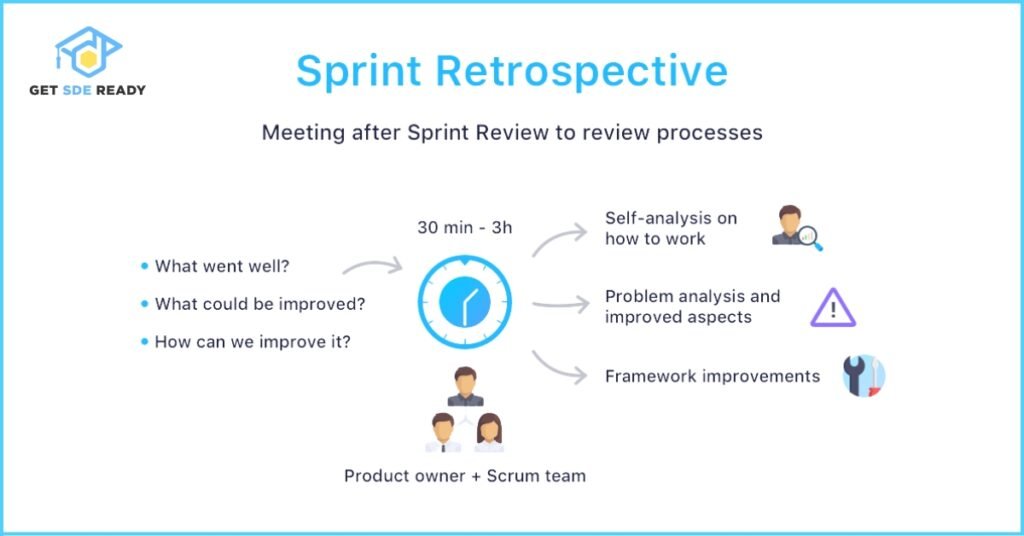
What is the purpose of a Sprint Review?
The Sprint Review aims to inspect the Increment and adapt the Product Backlog. It fosters collaboration with stakeholders, ensuring the product aligns with their needs through feedback and iterative adjustments.
How do you facilitate a Sprint Planning meeting?
As a facilitator, ensure the Product Owner presents clear, prioritized backlog items. Guide the Development Team to select achievable tasks, define the Sprint Goal, and create the Sprint Backlog. Encourage open discussion, clarify requirements, and keep the meeting time-boxed (typically 2-4 hours for a two-week Sprint).
Artifacts and Tools
What is a Product Backlog?
The Product Backlog is a dynamic, ordered list of all potential product requirements, managed by the Product Owner. It includes features, bug fixes, and technical tasks, prioritized based on business value, risk, or dependencies.
What is a Sprint Backlog?
The Sprint Backlog contains selected Product Backlog items for the current Sprint, along with a plan to deliver the Increment and achieve the Sprint Goal. It’s owned by the Development Team and serves as their roadmap.
What is an Increment?
The Increment is the sum of all completed Product Backlog items in a Sprint, combined with previous Sprints’ Increments. It must meet the Definition of Done, ensuring it’s usable and potentially releasable.
What are some common Agile tools?
Agile teams use tools to enhance collaboration and tracking:
- Jira: Manages workflows and Agile reporting.
- Trello: Offers visual task management with boards and cards.
- Asana: Organizes team tasks and projects.
- Microsoft Azure DevOps: Supports code sharing and delivery.
Explore technical skills with our Web Development course or DSA course.
Agile Principles and Values
What are the four values of the Agile Manifesto?
The Agile Manifesto emphasizes:
- Individuals and interactions over processes and tools.
- Working software over comprehensive documentation.
- Customer collaboration over contract negotiation.
- Responding to change over following a plan.
What are the 12 principles behind the Agile Manifesto?
The 12 principles include:
- Prioritize customer satisfaction through early, continuous delivery.
- Welcome changing requirements, even late in development.
- Deliver working software frequently.
- Foster daily collaboration between stakeholders and developers.
- Build projects around motivated individuals.
- Prefer face-to-face communication.
- Measure progress through working software.
- Promote sustainable development.
- Emphasize technical excellence.
- Maximize simplicity.
- Encourage self-organizing teams.
- Reflect and adapt regularly.
Deepen your knowledge with our Master DSA, Web Dev & System Design course.
Challenges and Best Practices
What are some common challenges in Agile projects?
Challenges include:
-
- Resistance to Change: Teams may resist Agile practices.
- Estimation Difficulties: Estimating task effort accurately.
- Stakeholder Expectations: Managing frequent updates or scope changes.
- Quality Consistency: Ensuring high-quality Increments.
- Scope Creep: Uncontrolled backlog additions.
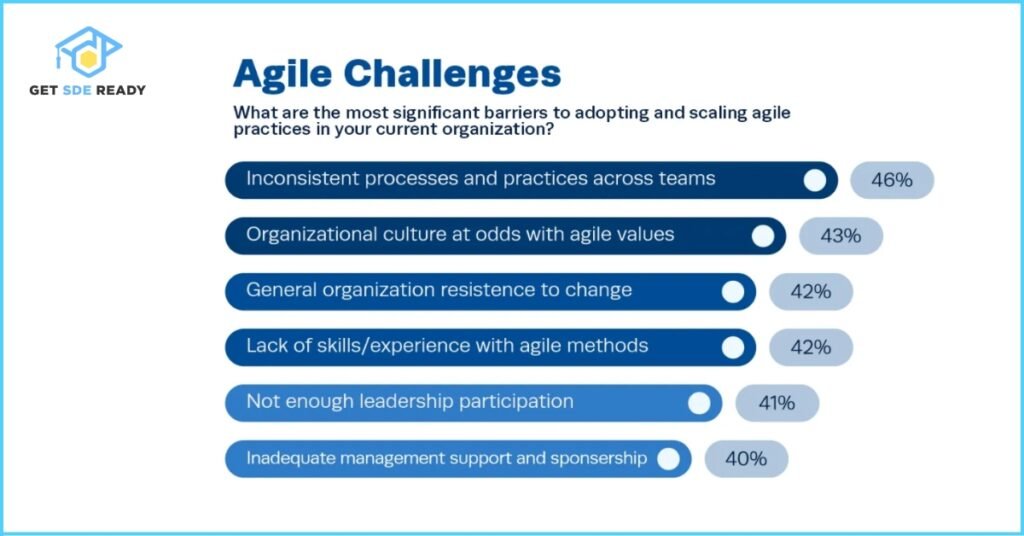
How can these challenges be overcome?
Strategies include:
- Training: Provide Agile and Scrum education.
- Communication: Maintain transparent stakeholder channels.
- Feedback: Use retrospectives for quick issue resolution.
- Prioritization: Apply techniques like MoSCoW.
- Continuous Improvement: Foster a culture of adaptation.
How do you handle conflicts within the Scrum team?
Address conflicts by:
- Facilitating Open Dialogue: Encourage team members to express concerns in a safe environment.
- Focusing on the Sprint Goal: Align discussions to shared objectives.
- Mediating as a Scrum Master: Remain neutral and guide resolution.
- Using Retrospectives: Identify root causes and prevent recurrence.
How do you ensure that the team is delivering value in each Sprint?
- Define a clear Sprint Goal aligned with stakeholder needs.
- Prioritize high-value backlog items with the Product Owner.
- Use metrics like velocity and burndown charts to track progress.
- Conduct Sprint Reviews to validate deliverables with stakeholders.
Additional Interview Questions
Below are additional questions commonly asked in Agile and Scrum interviews, with concise answers to help you prepare:
- What are the leading frameworks in Agile management software?
Leading frameworks include Scrum, Kanban, and Scaled Agile Framework (SAFe). Scrum uses sprints and defined roles, Kanban focuses on continuous flow, and SAFe scales Agile for large organizations. - Explain what the minimum and maximum duration of a Scrum cycle are.
Per the Scrum Guide, a Sprint lasts one month or less, typically 1-4 weeks, with 2 weeks being common for balancing delivery and feedback. - What are the latest developments in Agile management software?
In 2025, developments include Zoho Sprints’ Estimation Planner Extension, Miro’s advanced diagramming tools, and trends like AI-driven automation, mobile optimization, and enhanced security. - Explain the best Agile metrics.
Key metrics include Sprint Burndown, Velocity, Cycle Time, Cumulative Flow Diagram, and Quality Metrics (e.g., defect rates), which track progress, efficiency, and quality.
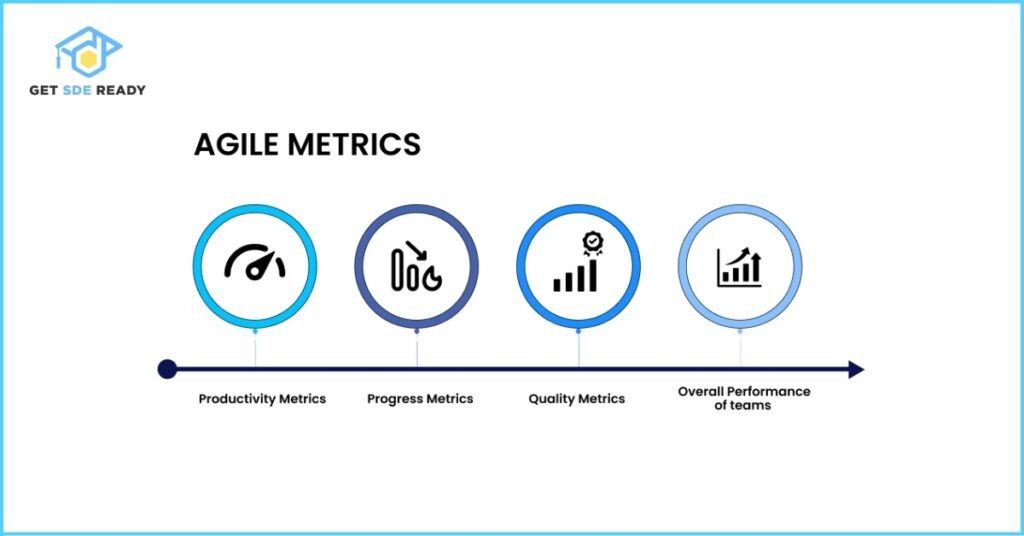
5. What is the difference between Agile and Scrum?
Agile is a broad methodology; Scrum is a specific framework within Agile, focusing on sprints and defined roles.
6. How does Scrum handle changes in requirements?
New requirements are added to the Product Backlog, prioritized by the Product Owner for future Sprints, ensuring flexibility.
7. What is the Definition of Done (DoD) in Scrum?
The DoD is a shared quality criteria ensuring the Increment is complete and releasable.
8. What are the three pillars of Scrum?
Transparency, Inspection, and Adaptation, which drive empirical decision-making.
9. What is the difference between a Product Backlog and a Sprint Backlog?
The Product Backlog is the full list of requirements; the Sprint Backlog is a subset selected for the current Sprint.
10. What is the difference between Agile and Waterfall methodologies?
Agile is iterative and adaptive; Waterfall is linear, with fixed phases and less flexibility.
11. How do you prioritize tasks in an Agile environment?
Use techniques like MoSCoW or WSJF, guided by the Product Owner’s prioritization based on value and risk.
12.What is the difference between Agile and Lean?
Agile focuses on iterative delivery and customer collaboration; Lean emphasizes waste reduction and efficiency.
13. How do you handle dependencies between teams in an Agile setting?
Coordinate through Scrum of Scrums, use SAFe for scaling, and ensure clear communication.
14. What is the role of technical debt in Agile projects?
Technical debt represents shortcuts that may require future rework. Manage it by allocating time for refactoring.
15. How do you ensure quality in Agile development?
Implement a strong Definition of Done, use automated testing, and conduct regular reviews.
16. What is the concept of velocity in Scrum?
Velocity measures the average work (story points) completed per Sprint, aiding in forecasting.
17. What is the difference between Kanban and Scrum?
Scrum uses fixed-length sprints; Kanban focuses on continuous flow with work-in-progress limits.
18. How do you conduct a Retrospective effectively?
Create a safe space, use structured formats (e.g., Start-Stop-Continue), and ensure actionable outcomes.
19. What is the importance of customer collaboration in Agile?
It ensures the product meets evolving needs through continuous feedback and iterative delivery.
20. How do you handle resistance to change when introducing Agile?
Educate stakeholders, demonstrate Agile benefits, and involve teams in the transition process.
21. What are some common anti-patterns in Scrum and how do you address them?
Examples include micromanaging or skipping ceremonies. Address through coaching and reinforcing Scrum values.
22. What is the role of automation in Agile testing?
Automation speeds up testing, ensures consistency, and supports continuous integration.
23. What are four differences between risk impact and risk probability?
-
- Risk Impact: Measures the severity of a risk’s effect (e.g., cost, schedule).
- Risk Probability: Assesses the likelihood of a risk occurring.
- Focus: Impact focuses on consequences; probability focuses on occurrence chance.
- Mitigation: Impact drives response planning; probability informs prioritization.
24 . Explain the role of Kanban boards within Agile.
Kanban boards visualize workflow, track tasks, and limit work-in-progress to optimize flow.
25. List some Agile project management tools and their roles in project planning.
Jira (workflow tracking), Trello (task visualization), Asana (task organization), Azure DevOps (delivery pipeline).
26. Who is instrumental in the Agile estimation technique, and why is estimation necessary?
The Development Team estimates tasks using techniques like Planning Poker. Estimation aids in planning and managing expectations despite potential inaccuracies.
27. How do you handle scope creep in Agile projects?
Manage through Product Backlog prioritization, stakeholder alignment, and clear Sprint Goals.
28. What is the role of the Product Owner?
The Product Owner maximizes value by managing the Product Backlog and aligning with stakeholders.
29. How do you measure the success of an Agile project?
Success is measured by delivering value, meeting customer needs, and achieving business goals, tracked via metrics like velocity and customer satisfaction.
30. What is the concept of a Sprint in Scrum?
A Sprint is a time-boxed period (1-4 weeks) where the team delivers a potentially releasable Increment.
|
Question |
Key Focus |
Why It’s Asked |
|
Leading Frameworks |
Understanding Agile methodologies |
Tests knowledge of Scrum, Kanban, SAFe |
|
Sprint Duration |
Scrum process details |
Ensures familiarity with Scrum Guide |
|
Agile Metrics |
Measuring performance |
Assesses ability to track progress |
|
Conflict Handling |
Team dynamics |
Evaluates leadership and mediation skills |
|
Value Delivery |
Customer focus |
Checks alignment with Agile principles |
Frequently Asked Questions (FAQs)
What is the difference between Agile and Scrum?
Agile is a broad methodology; Scrum is a specific framework within Agile, focusing on sprints and defined roles.
How long is a typical Sprint in Scrum?
Sprints typically last 1-4 weeks, with 2 weeks being common for frequent delivery and feedback.
What is the role of the Product Owner in Scrum?
The Product Owner maximizes product value by managing the Product Backlog and aligning with stakeholders.
What is the Definition of Done in Scrum?
The Definition of Done ensures the Increment meets quality criteria and is potentially releasable.
How does Scrum handle changes in requirements?
Changes are added to the Product Backlog, prioritized for future Sprints, ensuring flexibility.
Changes are added to the Product Backlog, prioritized for future Sprints, ensuring flexibility.
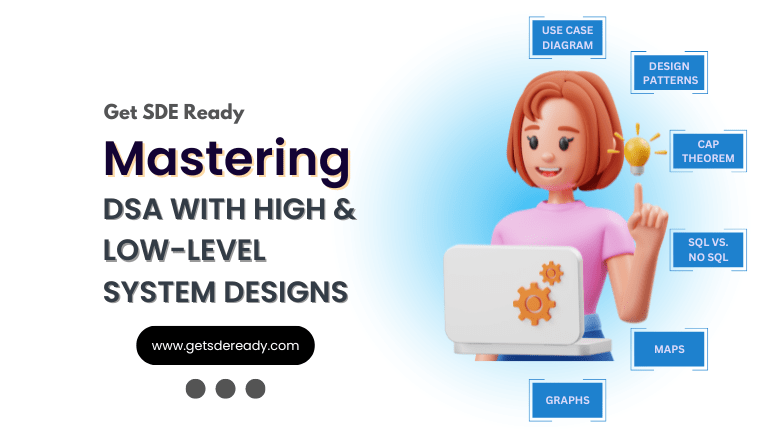
DSA, High & Low Level System Designs
- 85+ Live Classes & Recordings
- 24*7 Live Doubt Support
- 400+ DSA Practice Questions
- Comprehensive Notes
- HackerRank Tests & Quizzes
- Topic-wise Quizzes
- Case Studies
- Access to Global Peer Community
Buy for 52% OFF
₹25,000.00 ₹11,999.00
Accelerate your Path to a Product based Career
Boost your career or get hired at top product-based companies by joining our expertly crafted courses. Gain practical skills and real-world knowledge to help you succeed.
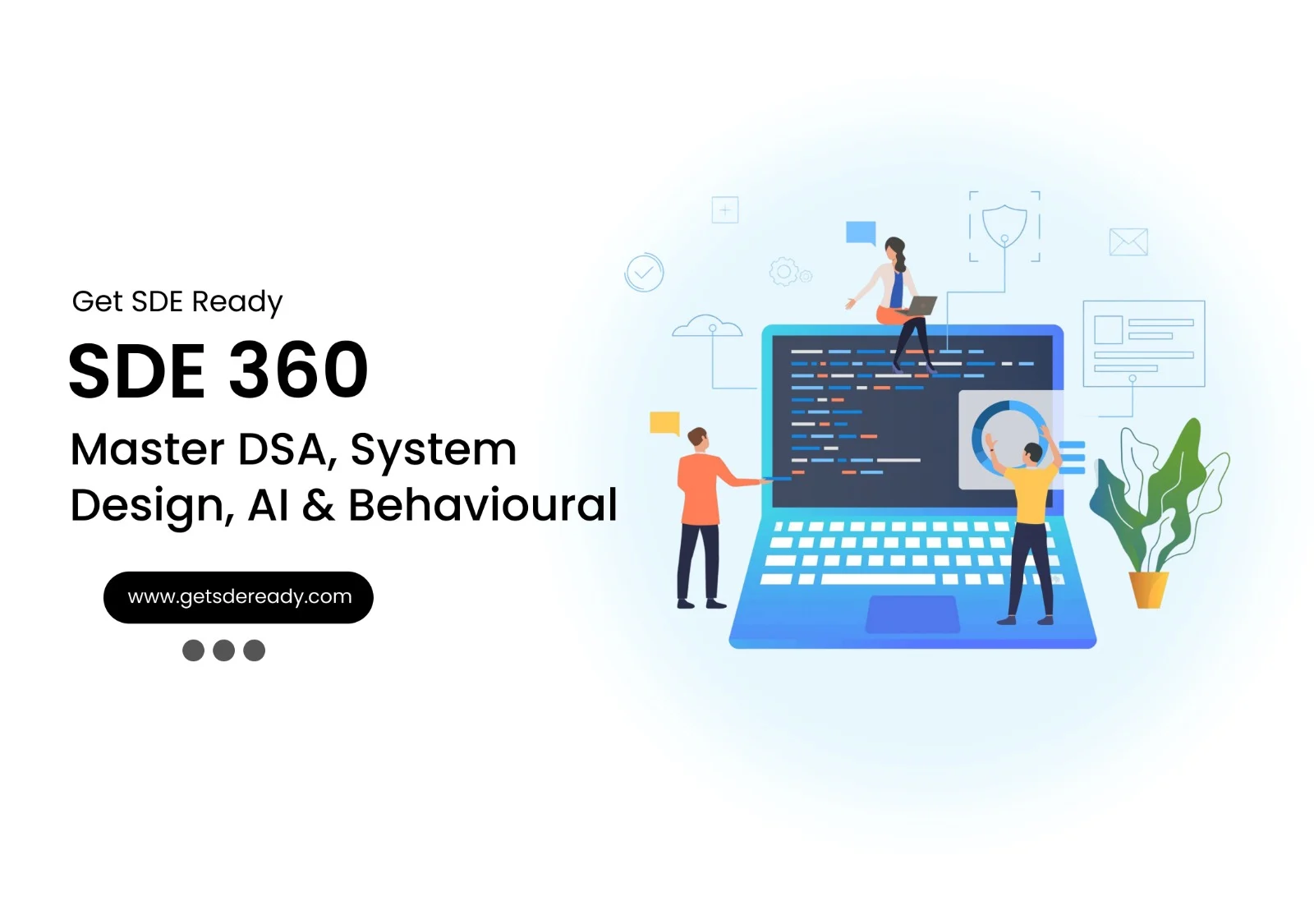
SDE 360: Master DSA, System Design, AI & Behavioural
- 100+ Live Classes & Recordings
- 24*7 Live Doubt Support
- 400+ DSA Practice Questions
- Comprehensive Notes
- HackerRank Tests & Quizzes
- Topic-wise Quizzes
- Case Studies
- Access to Global Peer Community
Buy for 50% OFF
₹39,999.00 ₹19,999.00

DSA, High & Low Level System Designs
- 85+ Live Classes & Recordings
- 24*7 Live Doubt Support
- 400+ DSA Practice Questions
- Comprehensive Notes
- HackerRank Tests & Quizzes
- Topic-wise Quizzes
- Case Studies
- Access to Global Peer Community
Buy for 52% OFF
₹25,000.00 ₹11,999.00
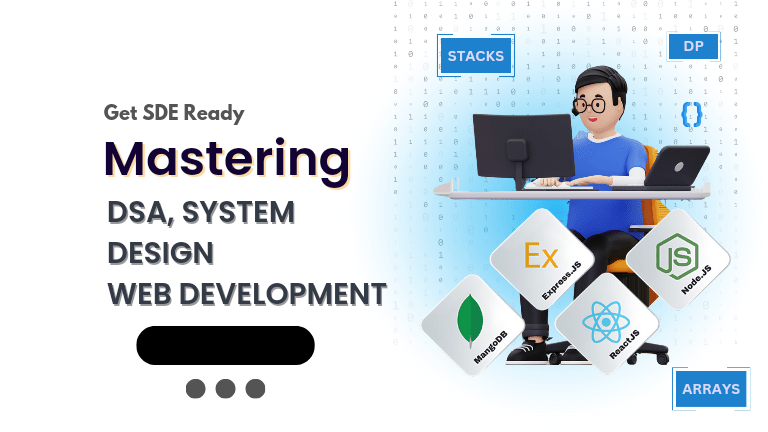
Fast-Track to Full Spectrum Software Engineering
- 120+ Live Classes & Recordings
- 24*7 Live Doubt Support
- 400+ DSA Practice Questions
- Comprehensive Notes
- HackerRank Tests & Quizzes
- 12+ live Projects & Deployments
- Case Studies
- Access to Global Peer Community
Buy for 51% OFF
₹35,000.00 ₹16,999.00

Low & High Level System Design
- 20+ Live Classes & Recordings
- 24*7 Live Doubt Support
- Case Studies
- Comprehensive Notes
- HackerRank Tests
- Topic-wise Quizzes
- Access to Global Peer Community
- Interview Prep Material
Buy for 60% OFF
₹20,000.00 ₹7,999.00
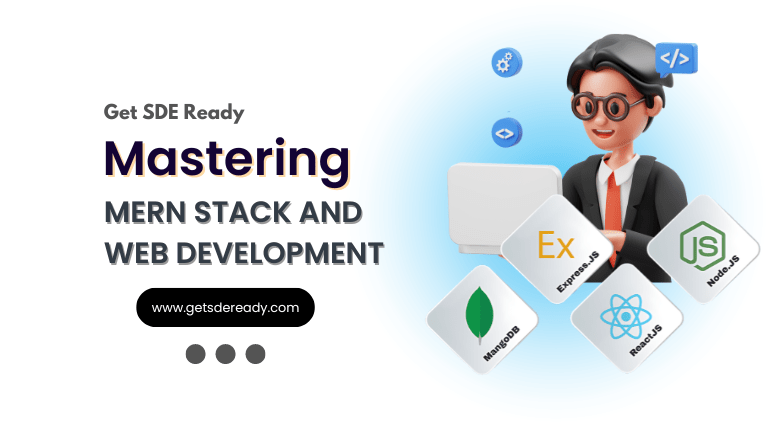
Mastering Mern Stack (WEB DEVELOPMENT)
- 65+ Live Classes & Recordings
- 24*7 Live Doubt Support
- 12+ Hands-on Live Projects & Deployments
- Comprehensive Notes & Quizzes
- Real-world Tools & Technologies
- Access to Global Peer Community
- Interview Prep Material
- Placement Assistance
Buy for 53% OFF
₹15,000.00 ₹6,999.00
Reach Out Now
If you have any queries, please fill out this form. We will surely reach out to you.
Contact Email
Reach us at the following email address.
arun@getsdeready.com
Phone Number
You can reach us by phone as well.
+91-97737 28034
Our Location
Rohini, Sector-3, Delhi-110085
